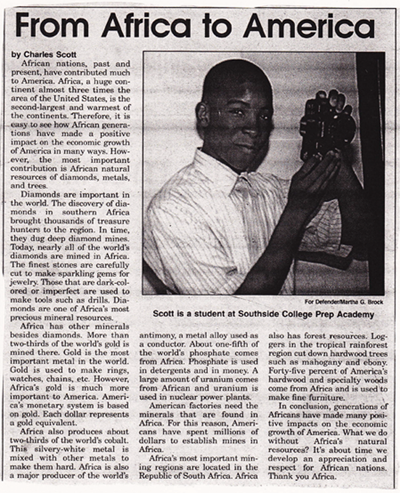Charles’s Engagement with Vernacular Journalism
One of Charles’s earliest memories of reading involves his great-aunt and great-uncle reading the newspaper at the kitchen table each morning. Charles recalled waiting impatiently for the sports page so that he could check the baseball scores and read what the local sports columnists had to say about the Cubs and the White Sox. He particularly enjoyed Jay Mariotti’s daily sports column in the sports section of the Chicago Sun-Times “because of his writing style and because he criticizes everyone, except Michael Jordan.” “Ever since then,” said Charles, “I’ve wanted to have my own sports column in a major newspaper.”
Charles’s interest in writing for a newspaper intensified in tenth grade when he won an essay contest sponsored by an African American sorority. In addition to a two hundred dollar gift certificate, the prize included having his essay read at an awards banquet and published in the Chicago Defender (see Figure 1 below). Recalling the experience during one of our early interviews, Charles stated, (the emphases are his)
I won an essay contest and it was the first time I ever won anything. This was when I started getting confidence, this was real important. They had an essay contest for high school and elementary school students and I won first place and I won a two hundred dollar gift certificate and they had a banquet where I came and read my essay and then the Defender [The Chicago Defender] published it. It really gave me confidence in writing and speaking; it really took off after that. That was real important. That was one of the most important, probably the most important thing in my writing.
With his interest in journalism piqued, Charles sought to take his high school’s journalism class, a course that involved writing stories for the school newspaper. Unfortunately, enrollment was limited to juniors and seniors. When his junior year did arrive, Charles excitedly signed up for the course and began writing for the school’s student newspaper. Although he only wrote for the paper for one year, many of his stories were published, including one which won the Excellent Sports Story Award from the Scholastic Press Association. Writing for and getting published in the student paper increased Charles’s confidence as a writer, and it also improved his status as a writer in others’ eyes as well. His peers held in him in higher esteem, as did many of his teachers: according to Charles, it was not until his English teacher saw his stories in the school paper that she thought of him as a “good writer.”
Buoyed by his success at his high school paper and wishing to further engage with journalism, Charles sought a position at New Expression, a monthly news magazine written by Chicago-area teens and distributed to 80,000 public and private high school students in the Chicago area. New Expression (available at http://digitalcommons.colum.edu/ycc_newexpressions/) was run by Youth Communication, a race-conscious program started in 1974 to promote urban minority youth participation in journalism and continued until 2008. Charles’s first three months at the magazine brought him a great deal of success. Along with multiple publications, including several front page stories, his efforts earned him the New Expression Rookie of the Year, New Expression Journeyman of the Year, and New Expression Most Improved Contributor awards. The following year, his stories earned him even more accolades, including the Kansas City Star Ernest Hemingway Writing Award for High School Journalists and a third-place award in the Lawrence Wade Journalism Fellowship Competition.
Charles’s trajectory with vernacular journalism continued as he entered the university in the fall of 2000. According to Charles, the transition from the news magazine to the university’s paper was not easy: “When I came here I thought ‘Well, I’m great’ because I had a bunch of national and local journalism awards I won in high school. But when I got [to the university], I learned that I’m not all I thought I was.” Whereas most new reporters undergo a few weeks of mentoring from more experienced writers, Charles’s mentoring period lasted six months. Following this somewhat rocky start, though, Charles began to publish regularly, and by the end of his third year as a reporter no less than 60 of his stories had been published, with several finding their way to the front page.
We turn now to three documented narratives that elaborate on the interplay between Charles’s vernacular journalism and the literate activity of three undergraduate courses: First-Year Rhetoric, Kinesiology, and Introductory Journalism. While the analysis produced a variety of accounts of interweaving, the three we present here were selected for a number of reasons. First, they illuminate the regular pattern of linkages between Charles’s vernacular journalism and his school writing over a number of years. Second, they provide detailed portraits of how such connections are made and maintained. Third, they highlight instances when the linkages had a significant impact on Charles’s performance on school tasks. Finally, these narratives illuminate the synergies and conflicts that can texture the linkages between literate activities.

